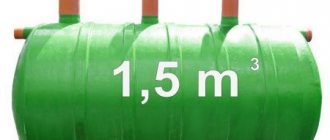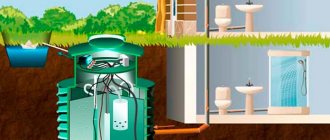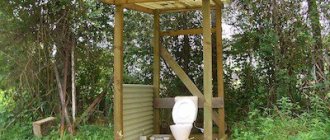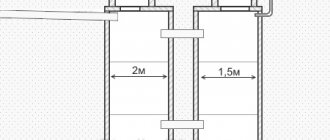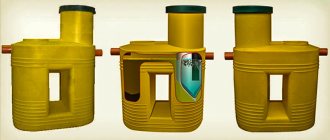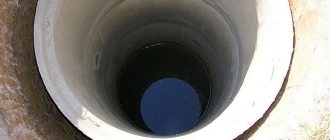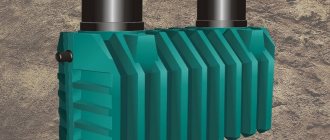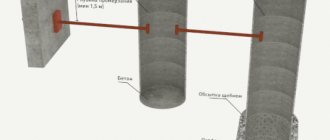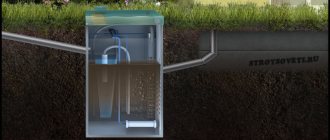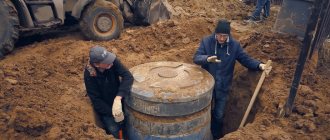Septic tank Microbe is a non-volatile, autonomous system for processing household wastewater. Designed for servicing small country and guest houses, bathhouses, and storm sewer collection.
Microbe brand products are manufactured by Triton Plastic. This is a well-known Russian manufacturer specializing in the production of large plastic containers. One of the main activities of the company is the creation of equipment for the collection and treatment of household wastewater. An example of one of the most successful developments of the enterprise is the Tank septic tank.
Description and purpose
Attention! Super discounts on products up to 50% Discounts on installation up to 30% FREE storage! Advance payment for the promotion with storage of only 50%
Don't wait for prices to go up, buy now at the lowest price.
The maximum possible discounts are currently in effect.
Book a date that is convenient for you for shipment and installation while the queue is forming and there is such an opportunity.
NO ONE HAS SUCH PRICES!!! HURRY!!!
CALL:
Moscow
| Russia |
Order
Order a specialist visit
HURRY! Prices valid ONLY until February 6th
Price list for non-volatile septic tank MICROB®
From February 6th price increase!!!
| Model | Dimensions (LxWxH), mm. | Volume, l. | Production, l./day | Weight, kg. | price, rub. PROMOTION! Only until February 6th! | |
| MICROB 450 | 810x810x1430 | 450 | 150 | 35 | 16 50012 400 | |
| MICROB 600 | 910x910x1430 | 600 | 200 | 42 | 19 50014 600 | |
| MICROB 750 | 1010x1010x1430 | 750 | 250 | 48 | 22 10016 600 | |
| MICROB 900 | 1110x1110x1430 | 900 | 300 | 54 | 24 00018 000 | |
| MICROB 1200 NEW 2021 | 1380x1170x1840 | 1200 | 450 | 80 | 25 00022 000 only 30 pcs. | |
| MICROB 1800 NEW 2021 | 1980x1170x1840 | 1800 | 800 | 110 | 32 00029 900 only 30 pcs. | |
| Infiltrator® | 1850x700x430 | — | 400 | 18 | 6 000 |
Prices are valid for Moscow and the Moscow region.
For details, please contact our specialists by phone: 8 and 8
Installation is carried out all year round.
Order
Order a specialist visit
Additional components for the MICROB® septic tank
For details, please contact our specialists by phone: 8 and 8
Order
Order a specialist visit
Description of the MICROB® septic tank
Septic tank MICROB is a completely new series of miniseptic tanks for comfortable living in small spaces, for example, country houses and guest houses, for baths, as well as temporary residence during construction, and as a storm sewer.
The body of the MICROB septic tank and the infiltrator (which serves as a receiver of wastewater from the septic tank and distributes it to the filtration field) is quite durable, made of low-density polyethylene, temperature range up to -30C.
MICROB is produced in a model range consisting of 4 septic tanks of various sizes. Moreover, even the smallest MICROB model is capable of ensuring the normal operation of an autonomous sewage system for a country house or other structure with constant operation of the mini-septic tank by one person and rare increases in the waste load (for example, in the case of guests arriving for the weekend).
Moreover, calculating the performance of a septic tank is quite simple. 1 person permanently residing in a dacha per day (or 15 large galvanized buckets). This volume is enough to fully use the toilet, sink and dishwasher. Accordingly, provided that guests arrive on weekends, the norm per person in dacha conditions can be reduced to 30 liters. knock (3 buckets of water), and you can safely calculate the number of guests.
An important factor that plays in favor of purchasing a MICROB septic tank is its micro-price (from 12,000 rubles), which is comparable to the purchase of an imported dry closet.
Service
Regular maintenance of the treatment device for country sewerage consists of cleaning filters and replenishing colonies of microorganisms. Timely maintenance will allow the unit to operate efficiently and extend its service life. When operating and servicing the device, follow the recommendations of specialists:
- To increase the lifespan of bacteria, it is necessary to use special biological products. These compositions help eliminate excessive gas formation in the chambers.
- It is recommended to install a special additional filter on the inlet pipe. This device will help protect the septic tank from aggressive household chemicals, which can cause destruction of the plastic casing.
- It is better to clean the container manually, since a sewer truck is not able to pump out sludge from such a small structure.
- No vehicles should be driven in the area where the treatment plant is installed, as the housing may not be able to withstand the load.
- In areas with high groundwater levels, it is necessary to use a special casing for the housing. It can be made of concrete, brick or steel mesh. This will prevent the unit from floating to the surface.
- Compaction of the soil at the site where the septic tank is installed must be done only manually without the use of special construction equipment.
Video instructions for installing Microbe septic tanks:
Advantages of the MICROB® septic tank
Ease of transportation
Light weight and small dimensions allow the MICROB to be transported even in passenger cars.
Basic maintenance
The MICROB septic tank needs to be cleaned once a year, before storing it for the winter.
Affordable price
The low cost of a septic tank of this series allows it to be used for various small buildings, such as country houses, bathhouses, temporary buildings, etc.
Performance
Despite its small size, MICROB can provide high performance for permanent residence of 1 person, and when a large number of guests arrive for the weekend.
Easy installation
Installation of a mini-septic tank is carried out independently, according to the attached instructions, as it does not require special skills and knowledge.
Energy independence
The MICROB septic tank operates autonomously (anaerobic operating principle, when bacteria do not need a constant supply of oxygen or pumping water from one chamber to another), i.e. does not depend on the power supply.
Important: persons installing a septic tank must know the rules for laying external sewer pipelines in accordance with the set of rules SP 32.13330.2012!
What methods are used?
Drainage can be treated using different methods. In Microbial septic tanks, wastewater is subjected to the following treatment:
- Settlement, that is, the separation from water of undissolved particles that differ in weight. Heavier particles fall to the bottom of the sump, while lighter contaminants (such as soap scum or grease) float to the top. Thus, relatively pure water accumulates in the very center of the liquid layer.
- Fermentation is anaerobic. This is a natural biological process that occurs without oxygen. Complex organic compounds are decomposed into simple components by bacteria.
In septic tanks, which include Microbe installations, no more than 75% of impurities are removed from the water. This level of purification is not sufficient to allow water to be discharged onto the ground; additional treatment must be organized.
To do this, special filters are built from sand and crushed stone, or additional biofilters are installed that provide aerobic biological purification of the liquid.
MICROB® septic tank installation diagrams
| Standard installation diagram for absorbent soils | Subject to absorbent soils and low groundwater levels | Subject to low groundwater levels |
| Subject to sandy soil and low groundwater levels | At high groundwater levels | |
| Installation diagram with filter field for low groundwater level | Installation diagram for absorbent soils | Installation diagram with a filtration well |
How does a wastewater treatment plant work?
The operating principle of a septic tank is based on two processes:
- settling of wastewater;
- interaction of liquid with anaerobic bacteria.
The device purifies water by approximately 85%. This degree of purification is not enough, so in addition to the equipment, drainage wells with additional filtration or filtration fields are built.
Drainage well with additional filtration (left) and filtration field (right)
Recommendations
After installing a septic tank, it is prohibited:
- Go deep into the ground to a depth of more than 1 m from the top edge of the product to the ground level;
- Use of construction equipment when backfilling a container;
- Compacting soil using construction equipment;
- Causing any mechanical damage;
- Passage of vehicles over an operating septic tank. If traffic is expected, it is necessary to pour a reinforced concrete platform 25 cm thick on top of the septic tank;
- Planting trees closer than 3 meters from the location of the septic tank or storage tank;
- Installation of a filter platform at a distance of less than 15 meters from wells and boreholes.
Installation
Since the Tank and Triton septic tanks are produced by the same company, their installation is very similar. The manufacturer recommends that the small vertical Mini and Microb models should not be anchored, but placed on a 10 cm layer of sand. Larger T-grade containers should be placed on a poured (installed) reinforced concrete slab. The procedure for installing small septic tanks is as follows:
- We dig a pit 30-35 cm larger than the dimensions of the container. In depth, it should be 10 cm deeper. When determining the depth, keep in mind that the lid must be on the surface.
- We dig trenches for sewer pipes - inlet from the house and outlet - to the post-treatment device. If you use plastic pipes with a diameter of 100 mm, they must run with a slope of at least 2 cm.
- The bottom of the pit is leveled and compacted (tamper to high density). Sand is poured onto the compacted soil in a layer of 5 cm, leveled and spilled. Then, in the same way - the second layer. It is leveled.
Installation diagram of the Triton Microbe septic tank
- They install the septic tank, check whether it is level by placing a level on the neck. It is necessary to check in all planes.
- Connect the pipes.
- Pour water into the container. When its level reaches 20-25 cm, we begin backfilling.
- They begin to fill the distance between the walls of the pit and the container with a mixture of sand and cement. For 1 part cement take 5 parts sand. The gap is filled with this mixture in layers of 20-30 cm. Lay the mixture around the circumference (perimeter), compacting thoroughly. It is prohibited to use equipment for compaction - only manual compaction. The entire gap is filled layer by layer. When working, make sure that the water level in the septic tank is 25-30 cm above the backfill level.
- Having reached the horizontal surface, insulation is laid on the body. This is usually polystyrene foam. The density needs to be high - it should not be crushed under the mass of earth that will be laid on top. The thickness depends on the region; for Central Russia 5 cm is enough.
- Geotextiles can be laid on top. It will prevent roots from growing into the insulation and destroying it.
- Next, everything is covered with “native” soil.
